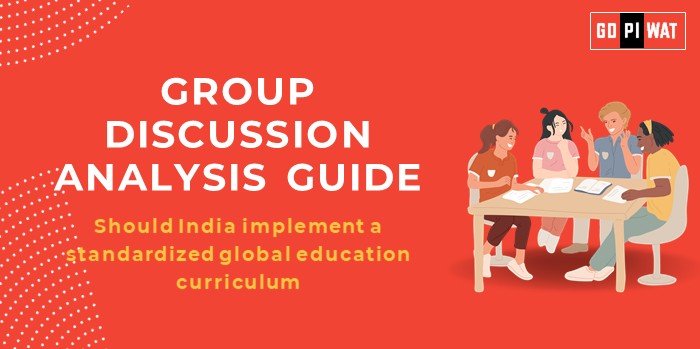📋 Group Discussion Analysis Guide: Should India Implement a Standardized Global Education Curriculum?
🌐 Introduction to the Topic
India’s education system, deeply rooted in traditional and regional curricula, faces ongoing debates about implementing a standardized global curriculum. Such a curriculum aims to equip students with competencies that are relevant worldwide. Advocates argue this would create uniform quality standards and prepare Indian students for global challenges, while critics highlight risks of cultural erosion and practical challenges given India’s diverse education landscape.
📊 Quick Facts and Key Statistics
- 🏫 Education System Size: Over 1.5 million schools and 250 million students, indicating the vast scale and impact of educational policy changes.
- 📉 Literacy Rate: 74% nationally, but disparities exist between rural and urban areas, highlighting the potential challenges in implementing a standardized curriculum.
- 📝 PISA Participation: India plans to rejoin the PISA test in 2024, a move towards global educational benchmarking.
- 🌍 UNESCO Global Learning Index: India ranks low in foundational skills, underscoring the potential benefits of aligning with global standards.
- 📚 National Education Policy (NEP) 2020: Emphasizes skill-based learning, which could integrate well with a global curriculum.
🧑🤝🧑 Stakeholders and Their Roles
- 🏛️ Central and State Governments: Crucial for policy creation and implementation, they must ensure alignment while respecting state-specific needs.
- 🏫 Schools and Universities: Would adopt the curriculum and adapt teaching methods to integrate global standards.
- 👪 Parents and Students: Key beneficiaries who would experience a shift in academic focus toward global competencies.
- 🌍 International Organizations (e.g., UNESCO, OECD): Provide expertise and frameworks for curriculum alignment and evaluation.
🏆 Achievements and ⚠️ Challenges
✅ Achievements
- 📜 National Education Policy 2020: Brought India closer to global education standards through its focus on critical thinking, digital skills, and multilingualism.
- 🌍 Increased Participation in International Assessments: Allows benchmarking with global standards.
- 💻 Digital Learning Initiatives: Programs like DIKSHA and SWAYAM expand access to resources aligning with global best practices.
⚠️ Challenges
- 🏚️ Regional Disparities: Differences in resources and infrastructure create uneven readiness for a global curriculum.
- 🗣️ Cultural and Linguistic Diversity: A one-size-fits-all approach may overlook local educational needs.
- 🌎 Global Comparison: Countries like Japan and Finland have maintained strong local curriculums while excelling globally, indicating that adaptation may be more feasible than a full overhaul.
📖 Case Study: Singapore’s Model: Adopted a balanced approach, blending global standards with local values, achieving high PISA rankings while preserving cultural identity.
🗣️ Structured Arguments for Discussion
- ✅ Supporting Stance: “A global curriculum would elevate India’s education standards, making its graduates competitive in a globalized job market.”
- ⚠️ Opposing Stance: “A standardized global curriculum could undermine India’s rich cultural diversity and may not address region-specific educational needs.”
- ⚖️ Balanced Perspective: “A hybrid approach that integrates global competencies with India’s unique cultural values could enhance both global competitiveness and local relevance.”
💡 Effective Discussion Approaches
- 📊 Opening Approaches:
- 📈 Data-Based Start: “India, with over 1.5 million schools, faces a vast challenge in implementing standardized education, but this move could level educational disparities.”
- 🧭 Cultural Contrast: “Balancing global standards with local culture presents a unique challenge, but countries like Singapore have shown it’s possible.”
- 🚀 Future-Oriented: “As we prepare for a more interconnected world, standardizing our curriculum could be a step toward global academic recognition.”
- 🛠️ Counter-Argument Handling:
- Rebutting Cultural Loss Concerns: Propose integrating cultural modules within a global curriculum.
- Addressing Feasibility: Suggest a phased rollout to allow regional adaptation and feedback.
📈 Strategic Analysis of Strengths and Weaknesses
- ✨ Strengths: Boosts global employability, aligns with international standards, and reduces regional disparities.
- ⚠️ Weaknesses: Risk of cultural loss, high implementation costs, and uneven infrastructure readiness.
- 🌟 Opportunities: Encourages international collaborations, promotes digital learning, and prepares students for modern careers.
- ⚡ Threats: Resistance from states, cultural skepticism, and risks of prioritizing global standards over holistic education.
💼 Connecting with B-School Applications
- 🌍 Real-World Applications: Curriculum standardization as a case study in policy implementation, operational management, and international education.
- 🎯 Sample Interview Questions:
- “How could India balance a global curriculum with its diverse cultural heritage?”
- “What would be the primary challenges in implementing a standardized curriculum across India?”
- 💡 Insights for B-School Students: Understanding stakeholder roles in policy, balancing cultural contexts with social change, and implementing global best practices in education.


